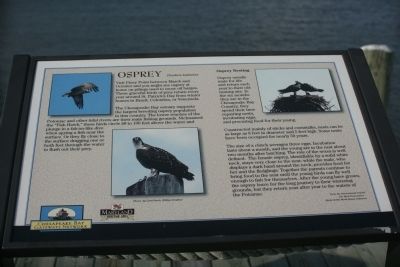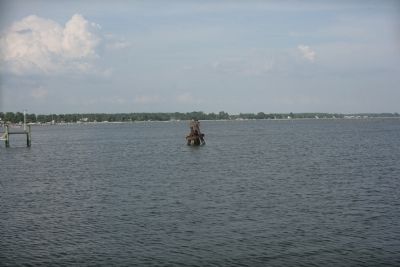Piney Point in St. Mary's County, Maryland — The American Northeast (Mid-Atlantic)
Osprey
Pandion haliaetus
The Chesapeake Bay estuary supports the largest breeding osprey population in the country. The lower reaches of the Potomac and other tidal waters are their main fishing grounds. Nicknamed the "Fish Hawk," these birds circle 50 to 100 feet above the water and plunge in a falcon-like dive whey spying a fish near the surface or they fly close to the surface dragging one or both feet through the water to flush out their prey.
Osprey Nesting
Osprey usually mate for life and return each year to their old nesting site. In the six month they are in the Chesapeake Bay Country, they spend their time repairing nests, incubating eggs and procuring food for their young.
Constructed mainly of sticks and cornstalks, nests can be as large as 8 feet in diameter and 5 feet high. Some nests have been occupied for nearly 50 years.
The size of the clutch averages three eggs. Incubation lasts about a month and the young are in the nest about two months after hatching. The role of the sexes is well defined. The female osprey, identifiable by a solid white neck, stays very close to the nest; while the male, who displays a dark band around the neck, provides food for her and the fledglings. Together the parents continue to bring food to the nest until the young birds can fly well enough to fish for themselves. After the young have grown, the osprey leave for the long journey to their wintering grounds, but they return year after year to the waters of the Potomac.
Erected by Maryland Department of Natural Resources.
Topics. This historical marker is listed in these topic lists: Animals • Waterways & Vessels.
Location. 38° 8.154′ N, 76° 31.748′ W. Marker is in Piney Point, Maryland, in St. Mary's County. Marker can be reached from Lighthouse Road. Marker is on a wharf near the Piney Point Lighthouse. Touch for map. Marker is in this post office area: Piney Point MD 20674, United States of America. Touch for directions.
Other nearby markers. At least 8 other markers are within walking distance of this marker. Potomac River Military Testing (here, next to this marker); Bay Lights (here, next to this marker); Map of Lower Potomac River and Chesapeake Bay (here, next to this marker); Piney Point Lighthouse (here, next to this marker); a different marker also named Piney Point Lighthouse (here, next to this marker); The Lighthouse Keeper's Quarters (here, next to this marker); a different marker also named Piney Point Lighthouse (here, next to this marker); Lighthouses of the Chesapeake (within shouting distance of this marker). Touch for a list and map of all markers in Piney Point.
Credits. This page was last revised on June 16, 2016. It was originally submitted on July 9, 2008, by Tom Fuchs of Greenbelt, Maryland. This page has been viewed 1,188 times since then and 15 times this year. Photos: 1, 2. submitted on July 9, 2008, by Tom Fuchs of Greenbelt, Maryland.

